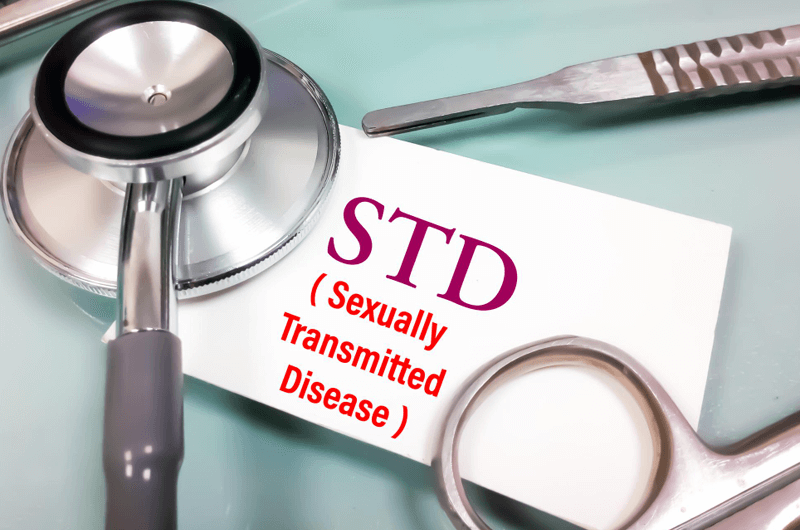Sexually transmitted diseases (STDs), previously referred to as “venereal disease”, are on the rise. Common STDs include genital herpes, human papillomavirus (HPV), chlamydia, gonorrhea, syphilis, and human immunodeficiency virus (HIV). STDs can be transmitted through infected bodily fluids exchanged during sexual contact or through the use of unsterilized drug needles, from mother to baby during childbirth, or breast-feeding, and even blood transfusions. A new CDC report indicates that rates of chlamydia, gonorrhea, and syphilis have all increased for a third year in a row. In 2016, these three infections accounted for more than two million STD cases, the highest number ever. The most common sexually transmitted disease in the US is chlamydia which, if left untreated, causes infertility, ectopic pregnancy, and pelvic inflammatory disease. HPV is the most common sexually transmitted disease that affects both men and women.
People who are sexually active should be screened for STDs at some point. The type of tests and when to get screened would depend on each individual’s personal risk factors. The CDC recommends obtaining regular sexual histories for every patient. To reverse the climbing STD rates, healthcare providers need to test, rapidly diagnose, and treat patients. A joint effort by clinicians and their medical coding companies is essential to ensure complete and accurate documentation, code assignment, and reporting of STD diagnoses and procedures.
Screening for STDs – Coverage Rules
The Affordable Care Act (ACA) mandates that private health plans provide coverage for a range of preventive services and may not impose cost sharing (such as copayments, deductibles, or co-insurance) on patients receiving these services. Services covered by private health plans vary by payer, and providers need to be knowledgeable about the covered services of their largest payers.
Private health plans may cover the following services:
- Screening for chlamydial infection for all sexually active non-pregnant young women aged 24 and younger and for older non-pregnant women who are at increased risk,
- Screening for chlamydial infection for all pregnant women aged 24 and younger and for older pregnant women who are at increased risk
- Screening for gonorrhea infection in all sexually active women, including those who are pregnant, if they are at increased risk
- Screening for syphilis infection for all pregnant women and for all persons at increased risk
- Screening for hepatitis B virus (HBV) infection in pregnant women at their first prenatal visit
- HIBC for the prevention of STIs for all sexually active adolescents, and for adults at increased risk for STIs
The STD Training and Technical Assistance Centers (STD TAC) lists the coverage rules for preventive services as follows:
- There is no cost sharing for patients when the visit is correctly coded as a screening and/or prevention visit and patients have not exceeded their annual number of allotted prevention visits.
- Coverage for screening and/or preventive services is not guaranteed for all visits.
- Recommended preventive services may be limited to once a year by private plans. In some situations, insurers may charge copayments and use other forms of cost sharing when paying for preventive services.
In the cases where recommendations for preventive services and counseling apply only to “high-risk” individuals, it falls on the healthcare provider to determine whether a patient belongs to the population in consideration.
STD screenings for chlamydia, gonorrhea, syphilis, and hepatitis B are covered once every 12 months, or at certain times during pregnancy. The coverage rules are as follows:
- Screening for Chlamydia and Gonorrhea
- Pregnant women age 24 years or younger when a pregnancy diagnosis is known, with repeat screening during the third trimester if high-risk sexual behavior has occurred since the initial screening test
- Pregnant women who are at increased risk for STIs when a pregnancy diagnosis is known, with repeat screening during the third trimester if high-risk sexual behavior has occurred since the initial screening test
- Women at increased risk for STIs, annually
- Screening for Syphilis
- Pregnant women when a pregnancy diagnosis is known, with repeat screening during the third trimester and at delivery if high-risk sexual behavior has occurred since the previous screening test
- Men and women at increased risk for STIs, annually
- Screening for Hepatitis B
- Pregnant women at the first prenatal visit when the diagnosis of pregnancy is known, with rescreening at time of delivery for those with new or continuing risk factors.
- Screening for HIV
A maximum of one, annual voluntary HIV screening is covered:- Between the ages of 15 and 65, without regard to perceived risk
- Younger than 15 or older than 65 who are at increased risk for HIV infection, as defined by the above-mentioned USPSTF guidelines
Pregnant women have different coverage parameters. A maximum of three voluntary HIV screenings for pregnant women is covered:
- When the diagnosis of pregnancy is known;
- During the third trimester; and
- At labor, if ordered by the woman’s clinician
Coding for STDs
- Preventive medicine service codes Preventive medicine service codes represent services provided in order to promote health and prevent illness or injury. These codes are used in the absence of complaints by the patient where counseling, anticipatory guidance, and/or risk reduction are provided. The extent and focus of preventive services mainly depend on the patient’s age. The “annual exam” is considered a preventive service and may include STI screening and preventive counseling. Documentation requirements for a preventive visit(“annual physical”) include age and gender appropriate history and physical examination, counseling or anticipatory guidance, and risk factor reduction interventions. Reimbursement would depend on comprehensive documentation which must include:
- New or established patient
- Age
- Complete review of systems (10 or more)
- Past medical, family and social history, and 8-organ system physical exam
- Anticipatory guidance
- Risk factor reduction
- ICD-10 codes for annual physical exams ICD-10 codes for counseling include prevention and screening Z codes. Coverage and reimbursement for these services may depend on the type of provider submitting the claim, the procedure/service and diagnosis codes submitted, and the patient’s contract with the insurance company. Annual physical exams should be reported using the following Z codes:
- Z01.411 Encounter for OB/GYN exam with or without PAP with abnormal findings
- Z01.419 Encounter for OB/GYN exam with or without PAP without abnormal findings
- Z00.00 Encounter for general adult medical without abnormal findings
- Z00.01 Encounter for general adult medical with abnormal findings
- ICD 10 coding for STD services
- Z11.3 Encounter for screening for infections with a predominantly sexual mode of transmission (excludes HPV and HIV)
- Z11.4 Encounter for screening HIV
- Z11.51 Screening for HPV
- Z11.59 Screening for other viral diseases
- Z11.8 Encounter for screening for other infectious and parasitic diseases (applicable to encounter for screening for chlamydia)
- Z11.8 Encounter for screening for other infectious and parasitic diseases (screening for chlamydia or syphilis, not gonorrhea)
- Z11.9 Encounter for screening for infectious and parasitic diseases, unspecified
- Z12.4 Encounter for screening for malignant neoplasm of cervix (excludes HPV)
- Z12.72 Encounter for screening for malignant neoplasm of cervix (excludes HPV)
- Z20.6 Contact or exposure to other viral diseases (HIV)
- Z20.828 Contact with exposure to other viral communicable diseases
- Z20.9 Contact with or exposure to communicable disease
- Z71.89 Counseling on other sexually transmitted diseases
- Z72.51 High‐risk sexual behavior
- Z72.52 High risk homosexual behavior
- Z72.53 High risk bisexual behavior
The following diagnosis codes should be used for STI screening in addition to the above codes, when appropriate:
- Z34.0x Encounter for supervision of normal first pregnancy
- Z34.8x Encounter for supervision of other normal pregnancy
- O09.9x Supervision of high risk pregnancy
Other ICD-10 codes associated with STI screening:
- A74.9 Chlamydial infection NOS
- A64 Unspecified sexually transmitted disease
- A63.0 Condyloma
- A59.9 Trichomoniasis
- B20 HIV
- R87.81 High Risk HPV positive test results
- R87.82 Low Risk HPV positive test results
- Gonorrhea: All gonococcal infections fall under A54 in ICD-10. The ICD-10 code for an acute gonorrhea infection is A54.00 and a gonococcal infection of the cervix is reported using ICD-10 code A54.03.
- Congenital syphilis: The A50 codes represent congenital syphilis. The ICD-10 codes for early syphilis come under A51 while those for late syphilis come under A52. Category A53 represents the ICD-10 codes for other/unspecified syphilis.
- Preventive medicine CPT codes
Preventive medicine codes are intended to be used in the absence of an established diagnosis. Individual counseling CPT codes 99401-99404: These codes are based on time and may be used for preventive STD counseling when the patient does not report symptoms of infection. Documentation should include time spent face-to-face with a credentialed clinician and specific preventive issues discussed. Counseling CPT codes do not include immunizations and ancillary studies involving laboratory, radiology, or other procedures that are reported separately. Group counseling CPT codes 99411-99412:These codes are used for group interventions. Note: Not all payers reimburse for these prevention counseling codes. Some private payers may reimburse the E/M CPT codes billed with the modifier 33. Providers should check with each specific insurance payer before providing any extensive preventive service. - Evaluation and management service CPT codes
Evaluation and management (E/M) codes are categorized into three key components: history, exam, and medical decision making. Office/outpatient codes 99201–99215 may be reported if the patient presents with any complaint, an abnormality is encountered, or a preexisting problem is addressed in the process of performing a preventive medicine service:- 99201-99205 for new patients: The minimum of all three key components is required for the code
- 99211-99215 for established patients: Only two of the three key components must meet or exceed criteria to qualify for a specific level of E/M service
- CPT codes associated with STI screening
- Chlamydia
- 86631 Antibody; Chlamydia
- 86632 Antibody; Chlamydia, IgM
- 87110 Culture, chlamydia, any source
- 87270 Infectious agent antigen detection by immunofluorescent technique; Chlamydia trachomatis
- 87320 Infectious agent antigen detection by enzyme immunoassay technique, qualitative or semiquantitative, multiple-step method; Chlamydia trachomatis
- 87490 Infectious agent detection by nucleic acid (DNA or RNA); Chlamydia trachomatis, direct probe technique
- 87491 Infectious agent detection by nucleic acid (DNA or RNA); Chlamydia trachomatis, amplified probe technique
- 87800 Infectious agent detection by nucleic acid (DNA or RNA), multiple organisms; direct probe(s) technique
- 87810 Infectious agent antigen detection by immunoassay with direct optical observation; Chlamydia trachomatis
- Gonorrhea
- 87590 Infectious agent detection by nucleic acid (DNA or RNA); Neisseria gonorrhea, direct probe technique
- 87591 Infectious agent detection by nucleic acid (DNA or RNA); Neisseria gonorrhea, amplified probe technique
- 87850 Infectious agent antigen detection by immunoassay with direct optical observation; Neisseria gonorrhea
- 87800 Infectious agent detection by nucleic acid (DNA or RNA), multiple organisms; direct probe(s) technique
- Syphilis
- 86592 Syphilis test, non-treponemal antibody; qualitative (eg, VDRL, RPR, ART)
- 86593 Syphilis test, non-treponemal antibody; quantitative
- 86780 Antibody; Treponema pallidum
- Hepatitis B
- 87340 Infectious agent antigen detection by enzyme immunoassay technique, qualitative or semiquantitative, multiple-step method; hepatitis B surface antigen (HBsAg)
- 87341 Infectious agent antigen detection by enzyme immunoassay technique, qualitative or semiquantitative, multiple-step method; hepatitis B surface antigen (HBsAg) neutralization
- HIV (HCPCS Level II)
- G0432 Infectious agent antibody detection by enzyme immunoassay (EIA) technique, HIV-1 and/or HIV-2, screening
- G0433 Infectious agent antibody detection by enzyme-linked immunosorbent assay (ELISA) technique, HIV-1 and/or HIV-2, screening
- G0435 Infectious agent antibody detection by rapid antibody test, HIV-1 and/or HIV-2, screening
- Chlamydia
Appropriate modifiers should also be used when submitting claims. For instance, modifier 25 is appended to the problem-oriented E/M visit.
According to a recent Harvard Health article, more than two million cases of chlamydia, gonorrhea, and syphilis were reported in 2016. STDs are on the rise among people of all ages. However, STDs are often underestimated and when undiagnosed and untreated and can have devastating health consequences for patients. Clinicians should take regular sexual histories for every patient and test and care for them and their partners, in accordance with the CDC’s recommendations.
With the rise in the incidence of STDs, clinicians can find medical coding for STDs a major challenge. To ensure appropriate reimbursement, providers should:
- Know the relevant ICD, CPT and modifier terminology and codes as well as which codes best represents the services provided
- Understand and follow the requirements and rules of government and commercial insurances
- Provide thorough documentation
Partnering with a reliable medical billing and coding company is a practical option to ensure accurate claim submission, payer compliant billing practices, and optimal reimbursement for STI screening.




